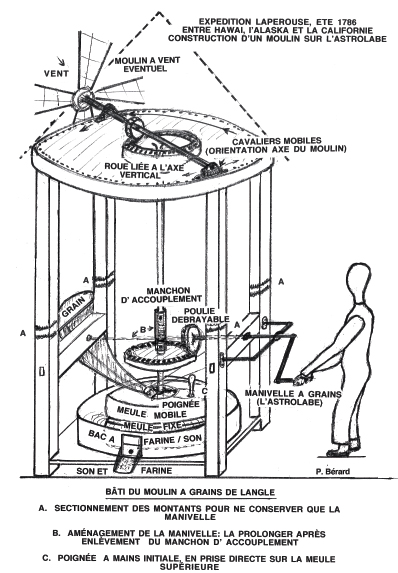The flour mills are an innovation of the Lapérouse expedition, known to the point of becoming a symbol of the silhouette of at least one ship.
It is also known that Captain de Langle was very inventive, especially in the field of culinary instruments for the health of the crews, which had to be preserved in such a long campaign.
The account of Laperouse’s voyage speaks of this on two occasions: after leaving the Hawaiian Islands (Maui) for Alaska, Laperouse was concerned about the health of the crews with the cooler weather that was appearing on the way north. He encourages various measures to fight against humidity, secretly adds cinchona to the rum in the toddy, and talks about grain, shipped to France and Chile in preference to flour, for conservation reasons.
A drawing by Duché de Vancy clearly shows the stern of Langle’s only ship with mill wings, while it was at anchor in the Baie des Français.

It is installed on the aft dunette, because it is the part of the ship that benefits from downwind sailing and the after wind.
It is also one of the few places on deck that is clear, although the mill has to cohabit with the mizzen sail, and its tack changes.
Placed immediately above the large chamber and the Commander’s cabin, it is possible that its noise and its handling by the crew at this place were not appreciated by the Staff, which would explain its short career.
It seems to have been used for the first time on De Langle’s “Astrolabe”, which moreover disembarked in Monterey (California), which is mentioned in the account of Lapérouse’s voyage in these terms:
“The women are hardly in charge of anything but the care of their household and that of their children, and of grinding and roasting the grains: this last operation is very painful and very long, because they have no other means to achieve it than to crush the grain on a stone with a cylinder.
Mr. De Langle, who witnessed this operation, presented his mill to the missionaries; it was difficult to render them a greater service; four women now do the work of a hundred.“


Model of the mill made by ALAF for the city of Monterey and for the Sydney Museum
It is also possible that Mr. de Langle wanted to get rid of his mill, very visible on the sketches of the Baie des Français in Alaska, to reuse in its place the hand millstone.
There was no mill on Lapérouse’s “Boussole”, probably because the half-dunette added on the back did not allow its fixation, or because of the experimental character of the “Astrolabe” installation.
The idea of the mill was taken up again on the two ships of d’Entrecasteaux, perhaps because in this revolutionary period, seeking to lighten the drudgery of the sailors was an indispensable attitude.
But there was no generalization of the system, although the sail remained the main mode of propulsion for more than a hundred years.
Hélène Richard describes in her study on the d’Entrecasteaux expedition the choice of this accessory
“According to an idea of Fleuriot de Langle, we wanted to avoid the drudgery of grinding the wheat carried in grain, and we had installed a windmill on each ship;
“We installed our windmill, which is carried by two crossbeams fixed on four extensions above the poop deck. The windmill slides on a slide made between the two extensions so that one can easily change tack”; one could thus lay out it so as to receive the most wind possible”.
The boat mill is of the “tower” type, that is to say that the orientable head (operated from the inside, or from the outside) which supports the wings and their axis of rotation slightly inclined upwards, is placed by means of a bearing or a circular slide, on the fixed vertical cylinder of the mill which contains the hopper, the grinding wheel, and the flour collecting tray.
The approximate dimensions of the whole are 2,50 m. of tower height, surmounted by a conical head of about 0,75 m, with 4 mill wings, of which the pair has 2,50 m. of diameter. There is no comment in Lapérouse’s diary on its efficiency, the minimum wind force required, the use at sea and at anchor in the harbor. These details were probably found in the lost diary of De Langle, who was interested in all the novelties such as the “cucurbite” for distilling sea water or the perfected English stove. The good health of the sailor was an indispensable condition for the success of the maritime expedition.



